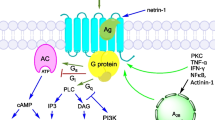Abstract
Divalent cation permeability of rat parotid gland basolateral plasma membranes was examined in dispersed parotid acini (by Ca2+ or Mn2+ entry) and in isolated basolateral plasma membrane vesicles (BLMV, by45Ca2+ influx). Mn2+ entry (fura2 quenching) was about 1.6 fold higher in internal Ca2+ pool-depleted acini (Ca2+-depl acini) than in unstimulated cells. Mn2+ entry into Ca2+-depl acini was increased at external pH>7.4 and decreased at pH<7.4. Pretreatment of Ca2+-depl acini with the relatively hydrophobic carboxylic group reagent, N,N′-dicyclohexylcarbodiimide (DCCD, 50 μM for 30 min) resulted in the inhibition of Mn2+ entry into Ca2+-depl acini to unstimulated levels. Another hydrophobic carboxyl group reagent, N-ethoxycarbonyl-2-ethoxy-1,2-dihydroquinoline (EEDQ) and the relatively hydrophilic carboxyl group reagents, 1-ethyl-3-(3-dimethylaminopropyl)carbodiimide (EDC) and 1-cyclohexyl-3-(2-morpholinoethyl)carbodiimide (CMCD) did not affect Mn2+ entry.
Similar to the effects in intact acini, Ca2+ influx into BLMV was decreased when the external pH was lowered below 7.4. Also DCCD (5 mM, 30 min), but not EEDQ, decreased (40%) Ca2+ influx in BLMV. However, unlike in acini, the hydrophilic reagents, EDC, EAC, and CMCD decreased Ca2+ permeability in BLMV and the effects were nonadditive with the decrease induced by DCCD. The aggregate effects of carboxyl group reagents on the Ca2+ and Mn2+ permeability in BLMV and intact acini, respectively, suggest that a critical carboxyl group (most likely accessible from the cytoplasmic side of the plasma membrane) is involved in divalent cation flux in rat parotid acinar cells.
Similar content being viewed by others
References
Ambudkar IS, Baum BJ: ATP-dependent calcium transport in rat parotid basolateral membrane vesicles is modulated by membrane potential. J Membr Biol 102: 59–69, 1988
Ambudkar IS, Melvin JE, Baum BJ: α-1-Adrenergic regulation of Cl− and Ca2+ movements in rat parotid acinar cells. Pflugers Arch 412: 75–79, 1988
Ambudkar IS, Lockwich TL, Hiramatsu Y, Baum BJ: Calcium entry in rat parotid gland cells. Mol Cell Biochem 114: 73–77, 1992
Baum BJ, Ambudkar IS, Helman J, Horn VJ, Melvin JE, Mertz LM, Turner RJ: Dispersed salivary gland acinar cell preparations for use in studies of neuroreceptor-coupled secretory events. Meth in Enzymol 192: 26–37, 1990
Bjerrum PJ, Andersen OS, Borders CL Jr, Wieth JO: Functional carboxyl groups in the red cell anion exchange protein. J Gen Physiol 93: 813–839, 1989
Changya L, Gallacher DV, Irvine RF, Potter BVL, Petersen OH: Inositol 1,3,4,5,-tetrakisphosphate is essential for sustained activation of the Ca2+-dependent K+ current in single perfused mouse lacrimal acinar cells. J Membr Biol 109: 85–93, 1989
Chueh SH, Gill DL: Inositol 1,4,5,-trisphosphate and guanine nucleotides activate calcium release from endoplasmic reticulum via distinct mechanisms. J Biol Chem 261: 13883–13886, 1987
Fasolato C, Pozzan T: Effect of membrane potential on divalent cation transport catalysed the electroneutral ionophores A23187 and ionomycin. J Biol Chem 264: 19630–19636, 1987
Hiramatsu Y, Baum BJ, Ambudkar IS: Elevation of cytosolic [Ca2+] due to internal Ca2+ release retards carbachol stimulation of divalent cation entry in rat parotid gland acinar cells. J Membr Biol 129: 277–286, 1992
Hoth M, Penner R: Depletion of intracellular Ca2+ stores activates a Ca2+ current in mast cells. Nature 355: 353–356, 1992
Karjalainen A, Bygrave FL: Evidence for the involvement of carboxyl groups in passive Ca2+ uptake by liver plasma membrane vesicles and in agonist-stimulated calcium uptake by hepatocytes. FEBS Lett 255: 441–444, 1989
Kuno M, Gardner P: Ion-channels activated by inositol 1,4,5,-trisphosphate in plasma membrane of human T-lymphocytes. Nature 326: 301–304, 1987
Luckhoff A, Clapham DE: Inositol 1,3,4,5,-tetrakisphosphate activates an endothelial Ca2+ permeable channel. Nature 355: 356–358, 1992
Merritt JE, Rink TJ: Regulation of cytosolic free calcium in fura2-loaded rat parotid acinar cells. J Biol Chem 262: 17362–17369, 1987
Mertz LM, Horn VJ, Baum BJ, Ambudkar IS: Calcium entry in rat parotid acini: activation by carbachol and aluminum fluoride. Am J Physiol 258: C654-C661, 1990
Mertz LM, Baum BJ, Ambudkar IS: Refill status of the agonist-sensitive Ca2+ pool regulates Mn2+ influx into parotid acini. J Biol Chem 265: 15010–15014, 1990
Mertz LM, Baum BJ, Ambudkar IS: Membrane potential modulates divalent cation entry in rat parotid acini. J Membr Biol 126: 183–193, 1992
Muallem S, Pandol SJ, Beeker TG: Modulation of agonist-stimulated calcium influx by extracellular pH in rat pancreatic acini. Am J Physiol 257: G917-G924, 1989
Penner R, Mathews G, Neher B: Regulation of calcium influx by second messengers in rat mast cells. Nature 334: 499–504, 1988
Petersen OH: Does inositol tetrakisphosphate play a role in receptor-mediated control of calcium mobilization? Cell Calcium 10: 375–383, 1989
Petersen OH, Gallacher DV: Electrophysiology of pancreatic and salivary acinar cells. Ann Rev Physiol 50: 65–80, 1988
Putney JW Jr: Identification of cellular activation mechanisms associated with salivary secretion. Ann Rev Physiol 48: 75–78, 1986
Takemura H, Hughes AR, Thastrup D, Putney JW Jr: Activation of Ca2+ entry by the tumour promoter thapsigargin in rat parotid acinar cells. Evidence that an intracellular Ca2+ store, and not an inositol phosphate, regulates Ca2+ fluxes at the plasma membranes. J Biol Chem 264: 12266–12271, 1989
Takemura H, Putney JW Jr: Capacitative regulation of calcium entry in parotid acinar cells. Biochem J 258: 409–412, 1989
Worley PF, Baraban JM, Suppatapone S, Wilson VS, Snyder SH: Characterization of inositol trisphosphate receptor binding in brain-regulation by pH and calcium. J Biol Chem 262: 12132–12136, 1987
Author information
Authors and Affiliations
Rights and permissions
About this article
Cite this article
Lockwich, T., Mertz, L.M. & Ambudkar, I.S. Involvement of carboxyl groups in the divalent cation permeability of rat parotid gland basolateral plasma membrane. Mol Cell Biochem 126, 143–150 (1993). https://doi.org/10.1007/BF00925692
Received:
Accepted:
Issue Date:
DOI: https://doi.org/10.1007/BF00925692




